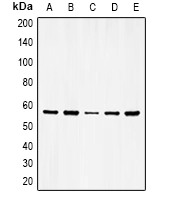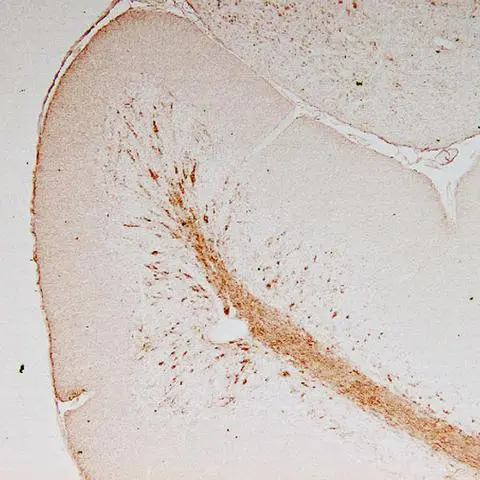![IHC-P analysis of human melanoma tissue using GTX80814 Vimentin antibody [J144]. Left : Primary antibody Right : Negative control without primary antibody Antigen retrieval : heat induced antigen retrieval was performed using 10mM sodium citrate (pH6.0) buffer, microwaved for 8-15 minutes Dilution : 1:1000 IHC-P analysis of human melanoma tissue using GTX80814 Vimentin antibody [J144]. Left : Primary antibody Right : Negative control without primary antibody Antigen retrieval : heat induced antigen retrieval was performed using 10mM sodium citrate (pH6.0) buffer, microwaved for 8-15 minutes Dilution : 1:1000](https://www.genetex.com/upload/website/prouct_img/normal/GTX80814/GTX80814_1419_IHC-P_w_23061322_923.webp)
IHC-P analysis of human melanoma tissue using GTX80814 Vimentin antibody [J144]. Left : Primary antibody Right : Negative control without primary antibody Antigen retrieval : heat induced antigen retrieval was performed using 10mM sodium citrate (pH6.0) buffer, microwaved for 8-15 minutes Dilution : 1:1000
Vimentin antibody [J144]
GTX80814
ApplicationsImmunoFluorescence, Western Blot, ImmunoCytoChemistry, ImmunoHistoChemistry, ImmunoHistoChemistry Paraffin
Product group Antibodies
TargetVIM
Overview
- SupplierGeneTex
- Product NameVimentin antibody [J144]
- Delivery Days Customer9
- Application Supplier NoteWB: 1:1,000. ICC/IF: 1:20-1:200. IHC-P: 1:20. *Optimal dilutions/concentrations should be determined by the researcher.Not tested in other applications.
- ApplicationsImmunoFluorescence, Western Blot, ImmunoCytoChemistry, ImmunoHistoChemistry, ImmunoHistoChemistry Paraffin
- CertificationResearch Use Only
- ClonalityMonoclonal
- Clone IDJ144
- ConjugateUnconjugated
- Gene ID7431
- Target nameVIM
- Target descriptionvimentin
- Target synonymsvimentin, epididymis secretory sperm binding protein
- HostMouse
- IsotypeIgM
- Protein IDP08670
- Protein NameVimentin
- Scientific DescriptionThis gene encodes a type III intermediate filament protein. Intermediate filaments, along with microtubules and actin microfilaments, make up the cytoskeleton. The encoded protein is responsible for maintaining cell shape and integrity of the cytoplasm, and stabilizing cytoskeletal interactions. This protein is involved in neuritogenesis and cholesterol transport and functions as an organizer of a number of other critical proteins involved in cell attachment, migration, and signaling. Bacterial and viral pathogens have been shown to attach to this protein on the host cell surface. Mutations in this gene are associated with congenital cataracts in human patients. [provided by RefSeq, Aug 2017]
- Storage Instruction-20°C or -80°C,2°C to 8°C
- UNSPSC12352203

![IHC-P analysis of human tonsil tissue using GTX80814 Vimentin antibody [J144]. Left : Primary antibody Right : Negative control without primary antibody Antigen retrieval : heat induced antigen retrieval was performed using 10mM sodium citrate (pH6.0) buffer, microwaved for 8-15 minutes Dilution : 1:1000 IHC-P analysis of human tonsil tissue using GTX80814 Vimentin antibody [J144]. Left : Primary antibody Right : Negative control without primary antibody Antigen retrieval : heat induced antigen retrieval was performed using 10mM sodium citrate (pH6.0) buffer, microwaved for 8-15 minutes Dilution : 1:1000](https://www.genetex.com/upload/website/prouct_img/normal/GTX80814/GTX80814_1420_IHC-P_w_23061322_249.webp)
![WB analysis of 20 ug of indicated whole cell lysates using GTX80814 Vimentin antibody [J144]. Dilution : 1:500 WB analysis of 20 ug of indicated whole cell lysates using GTX80814 Vimentin antibody [J144]. Dilution : 1:500](https://www.genetex.com/upload/website/prouct_img/normal/GTX80814/GTX80814_1960_WB_w_23061322_989.webp)
![ICC/IF analysis of HeLa cells untreated or treated with 1uM Actinomycin D for 19 hours using GTX80814 Vimentin antibody [J144]. Fixation : 4% paraformaldehyde Permeabilization : 0.1% Triton X-100 for 10 minutes ICC/IF analysis of HeLa cells untreated or treated with 1uM Actinomycin D for 19 hours using GTX80814 Vimentin antibody [J144]. Fixation : 4% paraformaldehyde Permeabilization : 0.1% Triton X-100 for 10 minutes](https://www.genetex.com/upload/website/prouct_img/normal/GTX80814/GTX80814_918_ICC-IF_w_23061322_495.webp)
![ICC/IF analysis of C6 cells using GTX80814 Vimentin antibody [J144]. Cells were probed without (right) or with(left) an antibody. Green : Primary antibody Blue : Nuclei Red : Actin Fixation : formaldehyde Dilution : 1:200 overnight at 4oC ICC/IF analysis of C6 cells using GTX80814 Vimentin antibody [J144]. Cells were probed without (right) or with(left) an antibody. Green : Primary antibody Blue : Nuclei Red : Actin Fixation : formaldehyde Dilution : 1:200 overnight at 4oC](https://www.genetex.com/upload/website/prouct_img/normal/GTX80814/GTX80814_919_ICC-IF_w_23061322_185.webp)
![ICC/IF analysis of HEK293 cells using GTX80814 Vimentin antibody [J144]. Cells were probed without (right) or with(left) an antibody. Green : Primary antibody Blue : Nuclei Red : Actin Fixation : formaldehyde Dilution : 1:200 overnight at 4oC ICC/IF analysis of HEK293 cells using GTX80814 Vimentin antibody [J144]. Cells were probed without (right) or with(left) an antibody. Green : Primary antibody Blue : Nuclei Red : Actin Fixation : formaldehyde Dilution : 1:200 overnight at 4oC](https://www.genetex.com/upload/website/prouct_img/normal/GTX80814/GTX80814_920_ICC-IF_w_23061322_904.webp)
![ICC/IF analysis of HeLa cells using GTX80814 Vimentin antibody [J144]. Cells were probed without (right) or with(left) an antibody. Green : Primary antibody Blue : Nuclei Red : Actin Fixation : formaldehyde Dilution : 1:200 overnight at 4oC ICC/IF analysis of HeLa cells using GTX80814 Vimentin antibody [J144]. Cells were probed without (right) or with(left) an antibody. Green : Primary antibody Blue : Nuclei Red : Actin Fixation : formaldehyde Dilution : 1:200 overnight at 4oC](https://www.genetex.com/upload/website/prouct_img/normal/GTX80814/GTX80814_921_ICC-IF_w_23061322_907.webp)
![FACS analysis of Jurkat cells using GTX17723 Vimentin antibody [VM452]. Black : Blank Grey : Isotype Control Green : Primary antibody](https://www.genetex.com/upload/website/prouct_img/normal/GTX17723/GTX17723_20200115_FACS_1470_w_23060620_227.webp)


![IHC-P analysis of human lung carcinoma tissue using GTX83095 Vimentin antibody [4F2E9].](https://www.genetex.com/upload/website/prouct_img/normal/GTX83095/GTX83095_20170912_IHC-P_w_23061322_341.webp)